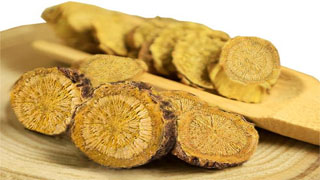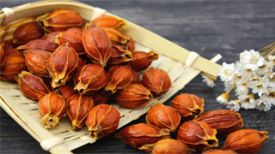
1. Alias
Camellia root, Scutellaria baicalensis tea, and Scutellaria baicalensis.
2. Plant morphology
Perennial herb. The whole plant is slightly hairy. Roots and stems grow vigorously or obliquely; Root conical, thick and robust, with a bright yellow cross-section. The stem is quadrilateral in shape, with many and thin branches from the base, and slightly woody at the base. Leaves alternate and opposite, nearly sessile, leaves are oblong or oblong ovate in shape, with indistinct rounded teeth or entire margins, dark green above and light green below, with sunken glandular points. Apiform inflorescence with leaf like bracts; Calyx with two lips, purple green in color, with shield like appendages on the back of the upper lip, enlarged during fruiting, membranous; Corolla with two lips, blue purple or purple red, upper lip helmet shaped, lower lip wide, often with light purple spots in the center, corolla tube thin, base abruptly curved, upright; Four stamens, slightly exposed, with white hairs on the fissure in the chamber; The ovary is deeply lobed and grows on a circular flower disk; The style is basal and the tip is 2-lobed. Nut 4, spherical, black brown; There is a tumor surrounded by an enlarged calyx. The flowering period is from June to September, and the fruiting period is from August to October.
3. Origin distribution
Born on dry mountain slopes facing the sun, commonly found on roadsides and grassy slopes. Distributed in Yunnan, Sichuan, Guizhou and other places.
4. Harvesting and processing
Excavate in spring and autumn, remove fibrous roots and sediment, sun dry and remove rough skin.
5. Characteristics of medicinal herbs
Conical or irregular strip-shaped, often branched, twisted, 5-20 cm long, 1-1.6 cm in diameter. The surface is yellow brown or brownish yellow, often with rough cork skin, and there are root marks at the bottom. Hard and brittle in texture, easy to break, fibrous in cross-section, bright yellow or slightly green in color. Mild odor, bitter taste.
6. Sexual Taste Returning to the Classics
Cold in nature and bitter in taste. Return to the Lung Meridian, Gallbladder Meridian, Spleen Meridian, Large Intestine Meridian, and Small Intestine Meridian.
7. Effect and Function
Clearing heat and dampness, purging fire and detoxifying, stopping bleeding, and preventing miscarriage. Belonging to the subcategory of clearing heat and dampness medicines, it is a type of heat clearing and dampness drying medicine.
8. Clinical application
Take 3-9 grams and decoct. Used to treat dampness and heat, chest tightness, nausea and vomiting, damp heat and fullness, diarrhea, jaundice, lung heat cough, high fever and thirst, blood heat and vomiting, abscesses, sores and toxins, and fetal restlessness.
9. Pharmacological research
Scutellaria baicalensis has a wide spectrum of antibacterial properties. In vitro experiments have shown inhibitory effects on bacteria and cocci, as well as influenza virus and skin fungi. It is clinically effective in treating viral eye diseases and upper respiratory tract infections. Animal experiments have shown that water decoction has anti-inflammatory, immune promoting, sedative and antipyretic effects; The extract has an inhibitory effect on HIV-1 growth. Has the effects of antimicrobial, anti allergic, hypotensive, diuretic, lipid-lowering, antiplatelet aggregation and anticoagulation, hepatoprotective, and renal injury protective; Low doses promote immune cell proliferation, while high doses inhibit it; Delaying the occurrence of cataracts.
10. Chemical composition
Containing flavonoids, which are effective ingredients of Scutellaria baicalensis, as well as small amounts of sterols and amino acids. Flavonoids mainly include baicalin, baicalein, wogonin, wogonin, wogonin, baicalein crude ragweed extract, etc., as well as mucilaginous baicalein, dihydrolignan A, etc.
11. Usage taboos
Those with spleen and stomach deficiency and cold, and those who eat less loose stools are prohibited from taking it.
12. Compatibility prescription
① To treat phlegm, fire, cough, shortness of breath and shortness of breath: 9 grams of Huangqin, 4.5 grams of Heishan Zhi and Suzi, and 3 grams of Poria cocos and Almonds each. Boil it in water. (Compendium of Materia Medica)
② To treat pulmonary tuberculosis and hot flashes, cough: 9-12 grams each of Scutellaria baicalensis and Salvia miltiorrhiza, 12-18 grams per hundred parts. Boil it in water. If taken as tablets or pills for a long time, it is particularly convenient. (Qin Bu Dan from Shanghai University of Traditional Chinese Medicine's "Pharmacology")
③ To treat Shaoyang headache and solar headache, without being biased: take slices of Scutellaria baicalensis, soak them in wine, and sun dry them into powder. Take 3 grams per serving, with tea and alcohol. (Little Clearing Cream from "The Secret Collection of the Orchid Chamber")
④ Treating stomach meridian heat, gum swelling, and inability to bleed: 3 grams each of Huangqin, Huanglian, Shengdihuang, Mudan skin, Shengma, and gypsum. Boil in water, take after eating. ("Authentic Surgery" Qingwei Powder)
⑤ Treating fetal heat and restlessness: divide Huangqin and Atractylodes macrocephala into equal parts. All of them are stir fried slightly, which is the size of wutong seeds, which are used as the final and honey refining pills. Every morning and evening, 9 grams of them are served in white soup. (Essentials of Danxi Compilation)
⊙ The content of the article is for clinical reference only. Non TCM professionals are not allowed to test drugs.


